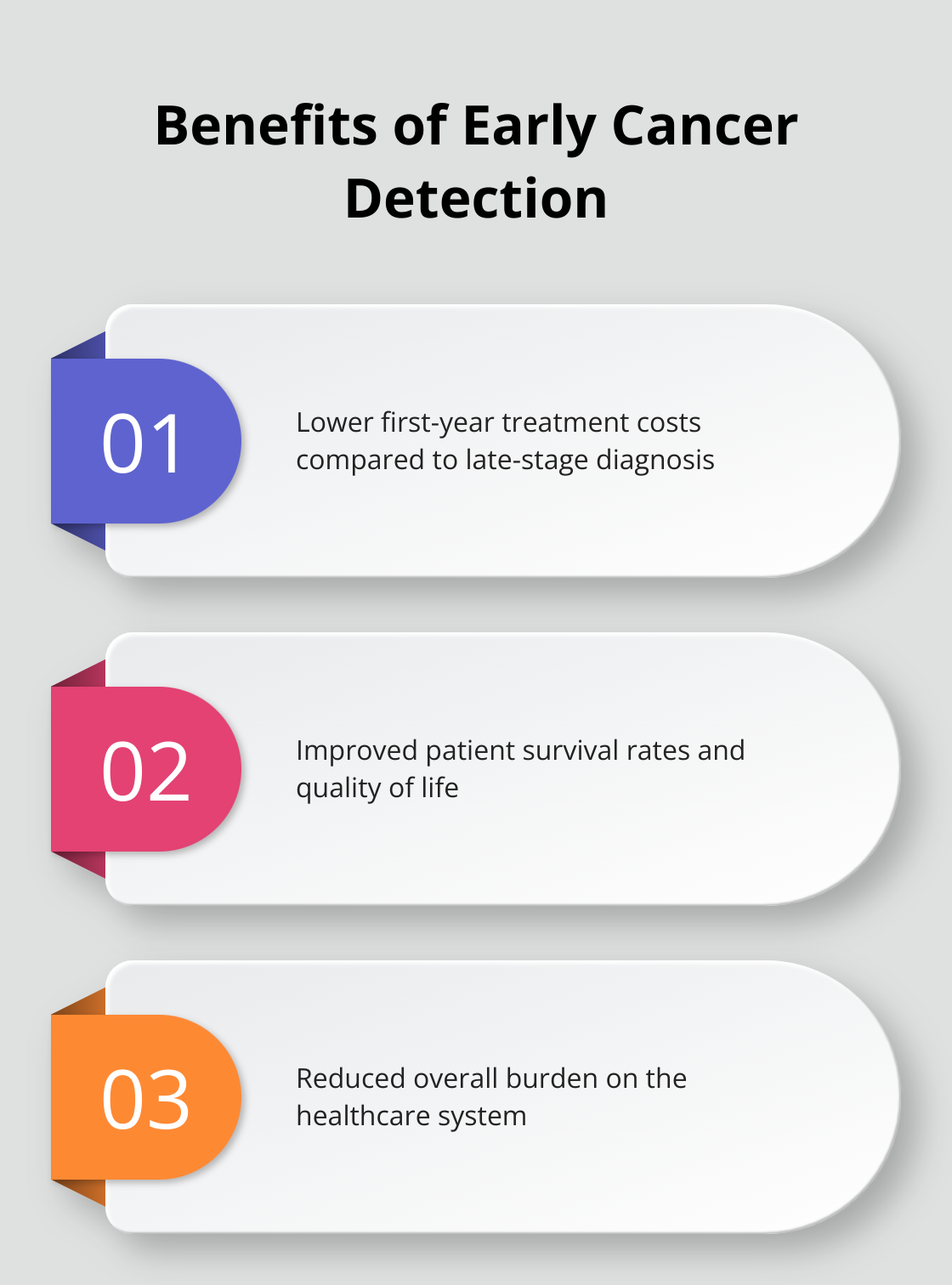Let’s talk about ScriberJoy. They get it—quality healthcare without breaking the bank. Sounds obvious, right? But here’s the kicker: it’s not about slashing budgets but playing it smart—a strategic tango that boosts patient outcomes and operational mojo.
What’s on the menu today? We’re diving into down-to-earth tactics to trim healthcare costs while keeping care top-notch. Stick with us—you won’t need a medical degree to see the value.
How Preventive Care Cuts Costs
Preventive care-it’s flipping the script on healthcare economics. Keeps folks healthier, longer, and gives your wallet a breather. Let’s dive into how this shifts the landscape of healthcare expenses.
Early Detection: A Financial Powerhouse
Catching diseases early isn’t just solid medicine-it’s fiscal genius playing out. Average expenses in the first year after diagnosis skyrocket when people get hit with late-stage colorectal cancer compared to the early stages. Those early screenings? They’re ringing the cash register in savings.
Regular health check-ups and screenings for the usual suspects (think diabetes, hypertension, various cancers) can really chop down long-term healthcare costs.

Health Education: The Cost-Saving Ripple
Patient education-let’s talk ripple effects of the dollar-bill-saving kind.
What’s on the table? Nutrition classes, smoking cessation programs, fitness initiatives. These aren’t just feel-good moves-they’re life-improving, cost-cutting maneuvers.
Remote Monitoring: The Tech Cost-Cutter
Tech is taking preventive care for a joyride. Remote patient monitoring (RPM)-it’s like having your health checked in real-time, minus the hospital revolving door.
A meta-analysis in JAMA Internal Medicine laid it bare: RPM slashes heart failure-related hospitalizations by 38%… and gives all-cause mortality a good 20% trim. A win for patients and healthcare systems? Check.

Starting RPM doesn’t need to be rocket science. Start simple-with devices like blood pressure monitors or glucose meters that shimmy up to smartphones. From there, healthcare pros can scale up to something more avant-garde as necessary.
These preventive strategies? Serious cost-cutters with big-time boosts to patient outcomes. What’s next? Smoothing out healthcare operations to usher in even more efficiency and cost bang-for-your-buck.
How to Streamline Healthcare Operations
Here’s the deal: Healthcare operations are the unsung heroes that keep everything humming along-ensuring care is delivered efficiently and cost-effectively. So, let’s dig into the nitty-gritty of optimizing these processes without sacrificing quality.
Efficient Administrative Processes
Administrative costs… they’re the elephant in the room, gobbling up roughly a quarter of hospital spending in the US (as per the Journal of the American Medical Association). Tackle this beast, and you unlock serious savings.
Centralizing scheduling and registration is a game-changer-think fewer headaches, less data entry, and fewer errors. Hospitals report 30% faster patient registration times after rolling out centralized systems. It’s a win.
Automation? A no-brainer for insurance verification. Slash claim denials by up to 80% and cut down the time on billing follow-ups. Patients get clearer info from the get-go, and providers can stop playing payment tag.
Electronic Health Records (EHR) Systems
EHR systems are flipping healthcare operations on their head. And no, it’s not just about kissing paper goodbye. It’s about working smarter-not harder. EHRs boost care quality, trim costs, help patient mobility, beef up info reliability, and let multiple providers access crucial patient info.
Optimization is the secret sauce. Regularly review and update your EHR workflows. This can claw back up to 45 minutes per clinician per day-according to the Office of the National Coordinator for Health Information Technology. That’s serious time back.
Training? Oh, it’s a must. Hospitals dishing out comprehensive EHR training report 10% higher physician satisfaction and keep turnover rates 7% lower. Pay up front-profit on the back end.
Accurate Medical Documentation
Now, documentation… that’s where the rubber meets the road. It’s the bedrock of efficient healthcare operations and impacts everything from patient safety to the financials.
Enter medical transcription services. ScriberJoy’s AI-powered transcription service hits over 99% accuracy, slashing documentation time significantly for healthcare pros.
Solid documentation means fewer claim denials. The American Health Information Management Association notes that beefed-up clinical documentation can chop claim denials by up to 80%-that goes straight to the bottom line.
Plus, sharp documentation backs better clinical decisions. A Journal of the American Medical Informatics Association study found it slashes unnecessary tests and procedures by 15%.
Streamlining operations isn’t about shortcuts-it’s playing it smart, harnessing tech, and keeping the spotlight on top-notch patient care. These tactics? They could cut costs left and right, while keeping or maybe even boosting the quality of care. Now, how about we dive into how embracing value-based care models can give healthcare cost-effectiveness another major boost?
Value-Based Care: Reshaping Healthcare Delivery
So, value-based care is shaking up healthcare delivery by putting quality above quantity. Think better patient outcomes while slashing costs – a win-win scenario for providers and patients. But how can healthcare organizations nail this value-based care thing?

Outcomes-Based Reimbursement
The buzzword shift here? We’re moving from fee-for-service to outcomes-based reimbursement – yup, the bedrock of value-based care. It’s not just about cranking up the volume of services anymore. We’re talking quality over quantity, and providers get the nod (and the paycheck) for delivering the good stuff.
According to a jaw-dropping reveal from the New England Journal of Medicine, hospitals on the value-based bandwagon chopped hospital-acquired conditions by 17% and shaved 8% off 30-day readmission rates. These are serious game changers, improving patient care and carving out big savings.
But pulling off outcomes-based reimbursement isn’t a walk in the park – you’ve gotta be a data whiz. Take the Mayo Clinic’s play – they boosted value-based care performance scores by 3.5% and raked in an extra $2.5 million in reimbursements. All about the data, folks.
Team-Based Care Coordination
Get this – care coordination is the secret sauce in value-based care models. It’s like assembling the Avengers of healthcare professionals to manage a patient’s care across different settings.
The Journal of General Internal Medicine dropped some knowledge: team-based care models slashed hospitalizations by 19% and emergency department visits by 36% for folks with gnarly chronic conditions.
Here’s how healthcare organizations can gang up for team-based care:
- Huddle up for regular team meetings to dive into patient cases
- Hook up with shared electronic health records for smooth info flow
- Appoint care coordinators – the real MVPs – to steer patient care across providers
Check out Geisinger Health System’s ProvenHealth Navigator model – they’re all about team-based care and managed to cut total medical costs by 7.1%, while patient satisfaction? A whopping 91%.
Bundled Payments for Episodic Care
Bundled payments – another pillar of the value-based care temple. It’s all about shelling out a single payment for everything linked to a specific episode of care, pushing for some real efficiency and coordination.
Medicare’s Bundled Payments for Care Improvement (BPCI) program is in the mix, handing out cash for 90-day care episodes post-hospital squeeze.
Thinking of jumping into bundled payments? Here’s the play-by-play:
- Kick-off with well-defined, everyday stuff like joint replacements
- Set down clear clinical pathways for consistent care
- Double down on data analytics to watch costs and outcomes
Baptist Health System in San Antonio went all-in on bundled payments for joint replacements, slicing the average cost per case by 20% – and the quality? Still top-notch.
Sure, turning the ship towards value-based care isn’t a walk in the park, but the upsides in better patient outcomes and slashed costs make it a no-brainer. For those who crack the code, a bright future in healthcare awaits.
Final Thoughts
Cost-effective healthcare-it’s not about cutting corners, folks. It’s about some next-level strategies that keep quality up and costs down. How? Preventive care, streamlined operations, and value-based models (that’s the magic sauce). And let’s talk about ScriberJoy’s AI-powered medical transcription service-delivering over 99% accuracy so healthcare pros can do what they do best: care for patients.
Now, this pivot to value-based care models-it’s a game-changer. We’re talking outcomes, not volume. Team-based approaches? Check. Bundled payments? You bet. Turns out, financial efficiency and top-notch care can be BFFs.
Looking forward, innovation is the name of the game in cost-effective healthcare. AI diagnostics, personalized medicine-it’s like sci-fi but real. The future is full of exciting possibilities to deliver high-quality care without breaking the bank. Healthcare providers ready to roll with these innovations? They’re gonna build a system that’s more affordable, effective, and all about the patient.

Leave a Reply
You must be logged in to post a comment.